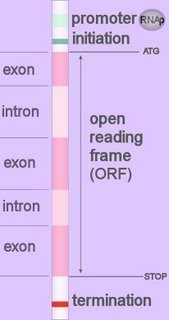 Because codons occur in nucleotide triplets, from any point within the genome there are six possible reading frames (three in each direction). Open reading frames (ORFs) are those sequences of DNA or RNA that code for translation at ribosomes into polypeptides or proteins. Within the genome, (ORFs) lie between codons for initiation (start-code sequence) and termination (stop-code sequence).
Because codons occur in nucleotide triplets, from any point within the genome there are six possible reading frames (three in each direction). Open reading frames (ORFs) are those sequences of DNA or RNA that code for translation at ribosomes into polypeptides or proteins. Within the genome, (ORFs) lie between codons for initiation (start-code sequence) and termination (stop-code sequence).A DNA open reading frame starts with ATG—coding for Met—in most species, and ends with a stop codon (TAA, TAG, or TGA).
In prokaryotes, ORFs are usually the longest sequence without a stop codon (without introns).
In eukaryotes, long ORFs can continue over non-translatable intron gaps, so spliced mRNA must be employed to determine ORFs. Short ORFs can occur outside genes – within the intron, segments of DNA outside genes that were formerly considered ‘junk’ DNA. (see image to left - click to enlarge)
Genomics Animations and Images - Genetics of Development - Animations and Images - Biology of Sex & Gender - Animations and Images - Genetically modified organisms - Animations and Images - Biodiversity - Animations and Images :
No comments:
Post a Comment
Note: Only a member of this blog may post a comment.